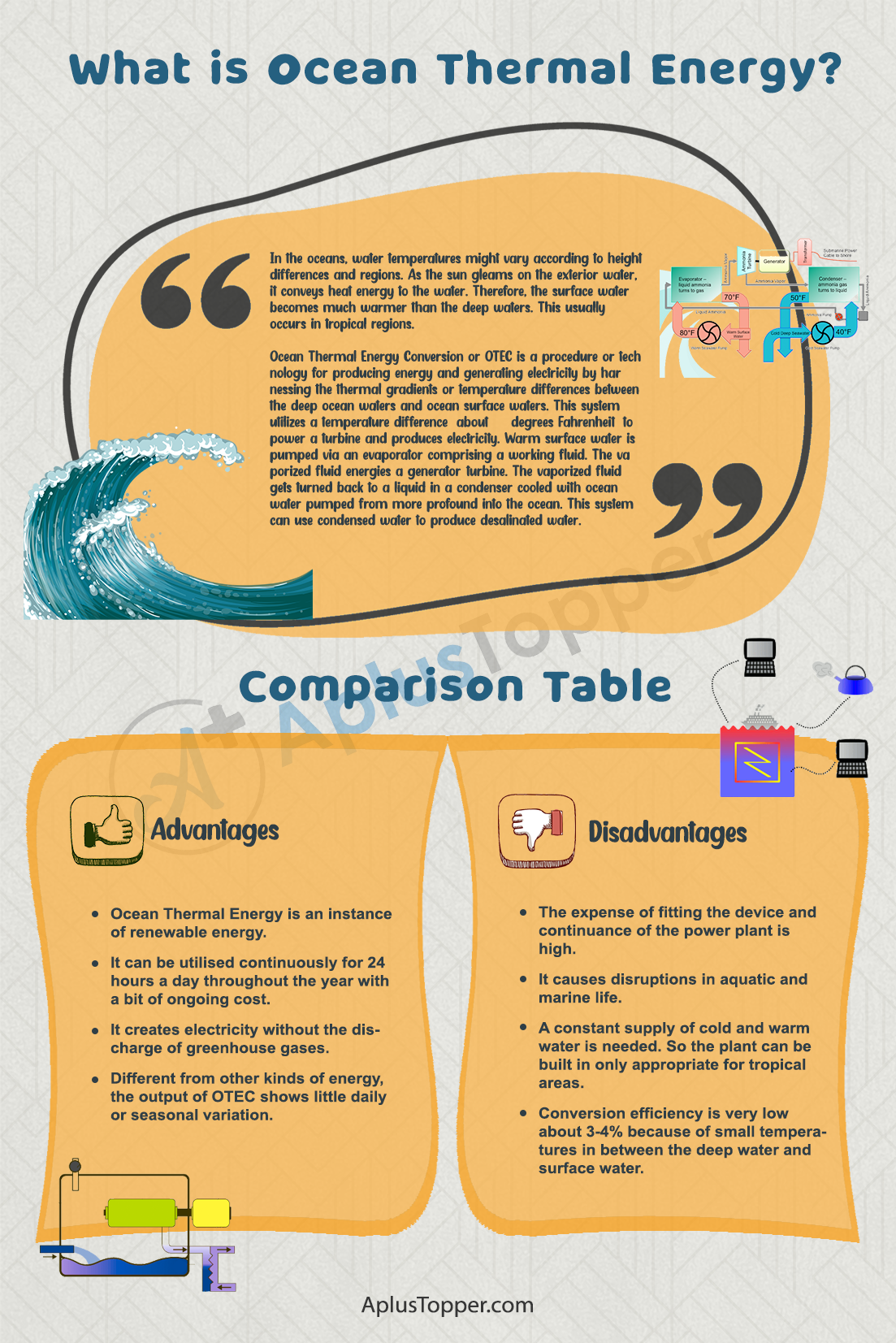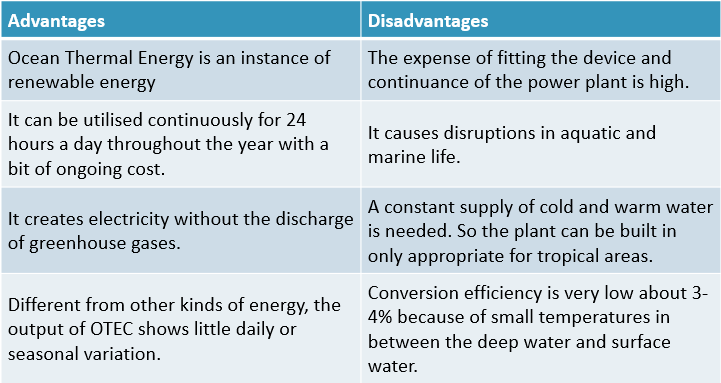Advantages and Disadvantages of Ocean Thermal Energy: In a world where we almost can’t live without electricity, the requirement for a more supply of energy grows with each passing day. The issue that arises is that most of our nations produce energy from the traditional burning of fossil fuels. By observing the pros and cons of ocean thermal energy, we might turn this belief.
Various substitute methods of clean energy like ocean thermal energy are accessible to us. But most of our nation barely makes use of it. Maximum of us are unaware of the fact that about 70 % of water covers the earth’s surface, which enables us to use it for various forms of energy production like ocean thermal energy.
Students can also find more Advantages and Disadvantages articles on events, persons, sports, technology, and many more.
What is Ocean Thermal Energy? Advantages and Disadvantages of Ocean Thermal Energy 2022
In the oceans, water temperatures might vary according to height differences and regions. As the sun gleams on the exterior water, it conveys heat energy to the water. Therefore, the surface water becomes much warmer than the deep waters. This usually occurs in tropical regions.
Ocean Thermal Energy Conversion or OTEC is a procedure or technology for producing energy and generating electricity by harnessing the thermal gradients or temperature differences between the deep ocean waters and ocean surface waters. This system utilizes a temperature difference (about 77 degrees Fahrenheit) to power a turbine and produces electricity. Warm surface water is pumped via an evaporator comprising a working fluid. The vaporized fluid energies a generator/turbine. The vaporized fluid gets turned back to a liquid in a condenser cooled with ocean water pumped from more profound into the ocean. This system can use condensed water to produce desalinated water.
In this post, we discussed at length some of the upsides and downsides of Ocean Thermal Energy.
- Advantages of Ocean Thermal Energy
- Disadvantages of Ocean Thermal Energy
- Comparison Table for Advantages & Disadvantages of Ocean Thermal Energy
- FAQs on Pros & Cons of Ocean Thermal Energy

Advantages of Ocean Thermal Energy
- Renewable Energy: OTEC is among the various green energy sources that are gaining a presence in some countries worldwide. Oceans are in full accessibility with about zero chances of ever running out. Also, the variance in temperatures in the ocean bodies will almost always occur. This causes the generation of ocean thermal energy renewable. Thus, we can generate electricity for a lifetime without this source draining.
- Clean energy: Nowadays, we might notice that many countries are trying to go green. That doesn’t apply to just tree planting but also to electrical power production. Clean energy production is an aim of the future for numerous countries. Ocean thermal energy is one of the common kinds of clean energy. The floating OTEC plants don’t need coal, natural, or any other fossil fuels to run, and thus the generation of electricity is through the water.
- Reliable: Even though we may get tempted to become excited over renewable energy production, some of the production techniques might prove unreliable. Due to weather variations, electrical generation techniques like wind or solar power can be inaccurate. Therefore, ocean thermal energy is a reliable source of energy due to having minimal variations. Hence, firms that provide ocean thermal energy don’t have to search for substitute techniques for electricity generation.
- Environmental friendly: The ocean thermal energy plants are mainly situated in the sea and away from human settlements. This makes sure that there is no interaction among the dense human population on the land and the energy plant. Also, hence it doesn’t need any usage of fossil fuels for production; it encourages the status of the environment and especially the atmosphere. We can thus get purer air when we adapt to ocean thermal energy production.
- Low Maintenance: Many of us would like to buy something long-lasting with little or no maintenance. Ocean thermal energy plants have such qualities. The machinery utilized, once it is installed, needs low maintenance. Also, the team wanted to achieve these floating OTEC plants that are primarily minor and hence cheap.
- Independent of Weather: We know that the ocean thermal energy power plants are situated in the water. Only the top portion appears like it is floating on the water. Therefore the weather doesn’t significantly affect these plants and is known to be a hurricane and all weather-proof.
Disadvantages of Ocean Thermal Energy
- The locality of Production: Just as with other energy generation techniques, we know many suitable places for this energy harnessing. This is a disadvantage to some countries with a coastal line or even landlocked nations.
- High Commercing Cost: We can see that the price to obtain and fix the required devices for controlling OTEC is relatively high. As we are at a time when the standards of living are high in many countries, establishing ocean thermal energy plants might be limited to some of our countries. And it might need a large number of professionals to install the plant.
- Interfere with navigation: The ocean thermal plant might appear as though it is floating on the water, but it has an enlarged and massive construction beneath the water. Large ships might experience difficulties in navigation with the floating body nearby.
- Slight temperature difference: The discrepancy in temperatures between surface water and deep water might be small. So, this may generate electric energy with moderate efficiency. It can also be very costly to small electricity businesses that depend on this form of energy production.
- Large size turbines with expensive liquid: The ocean thermal energy plant might need large sizes of turbines. These plants employ massive turbines because of the low stress in the boiling propene. The disadvantage comes in when the prices of turbines might be unaffordable and huge.
- Harmful on Marine life: The ocean thermal energy plant has pipes running down to the deepest parts of the ocean. Thus we can see that these pipes might disturb marine life. Also, small water animals might get drawn by force to the pipes through the pumping action of the water.

Comparison Table for Advantages and Disadvantages of Ocean Thermal Energy
| Advantages | Disadvantages |
| Ocean Thermal Energy is an instance of renewable energy | The expense of fitting the device and continuance of the power plant is high. |
| It can be utilised continuously for 24 hours a day throughout the year with a bit of ongoing cost. | It causes disruptions in aquatic and marine life. |
| It creates electricity without the discharge of greenhouse gases. | A constant supply of cold and warm water is needed. So the plant can be built in only appropriate for tropical areas. |
| Different from other kinds of energy, the output of OTEC shows little daily or seasonal variation. | Conversion efficiency is very low about 3-4% because of small temperatures in between the deep water and surface water. |

FAQ’s on Pros and Cons of Ocean Thermal Energy
Question 1.
What are the varieties of Ocean thermal energy?
Answer:
There are mainly three types of OTEC systems: open-cycle, closed-cycle, and hybrid.
Question 2.
What is the efficiency of ocean thermal energy?
Answer:
The maximum possible Carnot Thermal efficiency of an OTEC power system is about 7 percent as it exploits the water temperature gradient between the surface and the deep ocean, which is only a bit over 20 degrees Celsius in tropical waters.
Question 3.
Why is Ocean thermal energy vital?
Answer:
Ocean thermal energy conversion could be a vital source of renewable base-load energy for tropical islands and would support in relieving their present dependence on imported fossil fuels, specifically oil.
